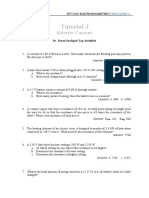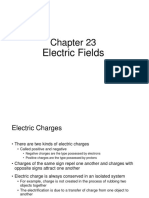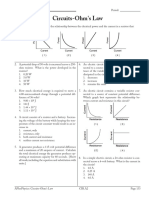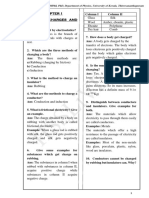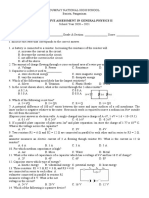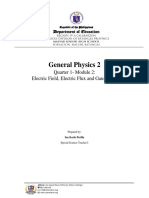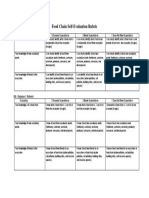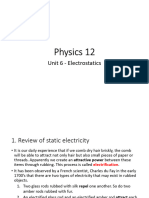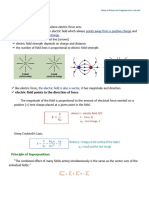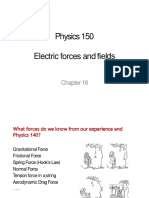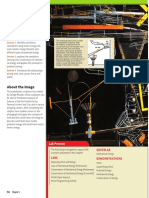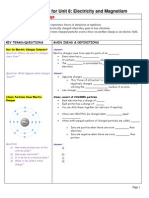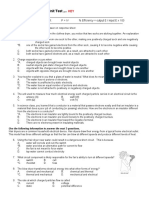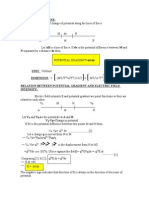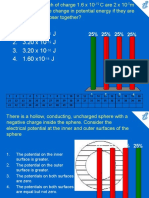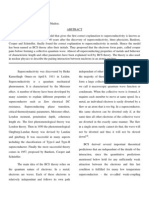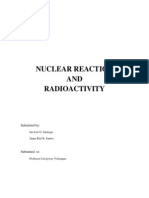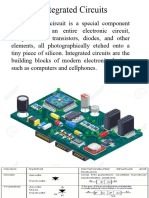CHAPTER 16 (ELECTROSTATICS: ENERGY & WORK)
1. If the distance between two negative point charges is increased by a factor of three, the resultant potential energy is what factor times the initial potential energy? a. 3.0 b. 9.0 c. 1/3 d. 1/9 2. An electron (charge -1.6 10-19 C) moves on a path perpendicular to the direction of a uniform electric field of strength 3.0 N/C. How much work is done on the electron as it moves 15 cm? a. 4.8 10-20 J b. -4.8 10-20 J c. 1.6 10-20 J d. zero 3. A proton (+1.6 10-19 C) moves 10 cm on a path parallel to the direction of a uniform electric field of strength 3.0 N/C. How much work is done on the proton by the electrical field? a. 4.8 10-20 J b. -4.8 10-20 J c. 1.6 10-20 J d. zero 4. A proton (+1.6 10-19 C) moves 0.10 m along the direction of an electric field of strength 3.0 N/C. The electrical potential difference between the protons initial and ending points is: a. 4.8 10-19 V b. 0.30V c. 0.033V d. 30.0 V 5. A 9 V battery is connected between two parallel metal plates 4 mm apart. What is the magnitude of the electric field between the plates? a. 2300 N/C b. 9 N/C
�c. 2.3 N/C d. 0.75 10-6 N/C 6. Four point charges are on the rim of a circle of radius 10 cm. The charges are (in microCoul) +0.5, +1.5, -1.0, -0.5. If the electrical potential at the circles center due to the +0.5 charge alone is 4.5 104 V, what is the total potential at the center due to the four charges combined? a. 18.0 104 V b. 4.5 104 V c. zero d. -4.5 104 V 7. If an electron is accelerated from rest through a potential difference of 1200 V, find its approximate velocity at the end of this process. (qe = 1.6 10-19 C; me = 9.1 10-31 kg) a. 1.0 107 m/s b. 1.4 107 m/s c. 2.1 107 m/s d. 2.5 107 m/s 8 . Three capacitors of 1.0, 1.5, and 2.0 microFarads are connected in series. Find the combined capacitance. a. 4.5 microFarads b. 4.0 microFarads c. 2.17 microFarads d. 0.46 microFarads 9. If three 4.0 F capacitors are connected in parallel, what is the combined capacitance? a. 12 microFarads b. 0.75 microFarads c. 8.0 microFarads d. 0.46 microFarads 10. A 10.0 microFarad capacitor is attached to a 20 V power supply. How much energy is stored in the capacitor?
�a. 2 10-3 J b. 1.2 10-3 J c. 2 10-4 J d. 5.2 10-4 J 11. to: The unit of electrical potential, the volt, is dimensionally equivalent
a. Joule Coulomb b. Joule/Coulomb c. Coulomb/Joule d. Farad Coulomb 12. The quantity of electrical potential, the Volt, is dimensionally equivalent to: a. force/charge b. force charge c. electric field distance d. electric field/distance 13. A free electron is in an electric field. With respect to the field, it experiences a force acting: a. parallel b. anti-parallel c. perpendicular d. along a constant potential line 14. At which location will the electric field between the two parallel plates of a charged capacitor be the strongest in magnitude? a. near the positive plate b. near the negative plate c. midway between the two plates d. electric field is constant throughout space between plates 15. The unit of capacitance, the farad, is dimensionally equivalent to which of the following? a. volt/coulomb b. volt coulomb c. joule/volt d. coulomb/volt
�16. Inserting a dielectric material between two charged parallel conducting plates, originally separated by air and disconnected from a battery, will produce what effect on the capacitor? a. increase charge b. increase voltage c. increase capacitance d. decrease capacitance 17. Increasing the separation of the two charged parallel plates of a capacitor which are disconnected from a battery will produce what effect on the capacitor? a. increase charge b. decrease charge c. increase capacitance d. decrease capacitance 18. Increasing the voltage across the two plates of a capacitor will produce what effect on the capacitor? a. increase charge b. decrease charge c. increase capacitance d. decrease capacitance 19. Which of the following characteristics are held in common by both gravitational and electrostatic forces when dealing with either point masses or charges? a. inverse square distance law applies b. forces are conservative c. potential energy is a function of distance of separation d. all of the above choices are valid 20. A uniform electric field, with a magnitude of 5 102 N/C, is directed parallel to the positive x-axis. If the potential at x = 5 m is 2500 V. What is the potential at x = 2 m? a. 1000 V b. 2000 V c. 4000 V d. 4500 V 21. A uniform electric field, with a magnitude of 5 102 N/C, is directed
�parallel to the positive x-axis. If the potential at x = 5 m is 2500 V, what is the change in potential energy of a proton as it moves from x = 5 m to x = 2 m? (qp = 1.6 10-19 C) a. 8.0 10-17 J b. 2.4 10-16 J c. 1.9 1021 J d. 500 J 22. Find electrical potential at 0.15 m from a point charge of 6.0 microCoul. (k = 9 109 N-m2/C2) a. 5.4 104 V b. 3.6 105 V c. 2.4 106 V d. 1.2 107 V 23. Two point charges of values +3.4 and +6.6 microCoul, respectively, are separated by 0.20 m. What is the potential energy of this 2-charge system? (k = 9 109 N-m2/C2) a. +0.34 J b. -0.75 J c. +1.0 J d. -3.4 J 24. Two point charges of values +3.4 and +6.6 microCoul are separated by 0.10 m. What is the electrical potential at the point midway between the two point charges? (k = 9 109 N-m2/C2) a. +1.8 106 V b. -0.9 106 V c. +0.9 106 V d. +3.6 106 V 25. An electron in a cathode ray tube is accelerated through a potential difference of 5 kV. What kinetic energy does the electron gain in the process? (qe = 1.6 10-19 C) a. 1.6 10-16 J b. 8.0 10-16 J c. 1.6 10-22 J d. 8.0 1022 J
�26. An electron in a TV picture tube is accelerated through a potential difference of 10 kV before it hits the screen What is the kinetic energy of the electron in electron volts? (1 eV = 1.6 10-19 J) a. 1.0 104 eV b. 1.6 10-15 eV c. 1.6 10-22 eV d. 6.25 1022 eV 27. A 0.25 microFarad capacitor is connected to a 400 V battery. Find the charge on the capacitor. a. 1.2 x10-12 C b. 1.0 x10-4 C c. 0.040 C d. 0.020 C 28. A 0.25 microFarad capacitor is connected to a 400 V battery. What potential energy is stored in the capacitor? a.1.2 x10-12 J b.1.0 x10-4 J c.0.040 J d.0.020 J 29. Two capacitors with capacitances of 1.0 and 0.5 microFarads, respectively, are connected in parallel. The system is connected to a 100 V battery. What charge accumulates on the 1.0 microFarad capacitor? a. 150 microCoul b. 100 microCoul c. 50 microCoul d. 33 microCoul 30. Two capacitors with capacitances of 1.0 and 0.5 microFarads, respectively, are connected in parallel. The system is connected to a 100 V battery. What electrical potential energy is stored in the 1.0 microFarad capacitor? a. 1.7 10-3 J b. 7.5 10-3 J c. 5.0 10-3 J d. 10.0 10-3 J 31. Two capacitors with capacitances of 1.0 and 0.5 microFarads,
�respectively, are connected in series. The system is connected to a 100 V battery. What charge accumulates on the 1.0 microFarad capacitor? a. 150 microCoul b. 100 microCoul c. 50 microCoul d. 33 microCoul 32. Two capacitors with capacitances of 1.0 and 0.5 microFarads, respectively, are connected in series. The system is connected to a 100 V battery. What electrical potential energy is stored in the 1.0 microFarad capacitor? a .0.065 10-3 J b. 4.30 10-3 J c. 0.80 10-3 J d. 5.45 10-4 J 33. At what distance from a point charge of 8.0 microCoul would the electrical potential be 4.2 104 V? (k = 9 109 N-m2/C2) a. 0.58 m b. 0.76 m c. 1.71 m d. 2.94 m 34. A point charge of +3 microCoul is located at the origin of a coordinate system and a second point charge of -6 microCoul is at x = 1.0 m. What is the electric potential at the x = 0.5 m point? (k = 9 109 N-m2/C2) a. 16.2 104 V b .10.8 104 V c .-10.8 104 V d. -5.4 104 V 35. A point charge of +3 microCoul is located at the origin of a coordinate system and a second point charge of -6 microCoul is at x = 1.0 m. At what point on the x-axis is the electrical potential zero? a. -0.25 m b. +0.25 m c. +0.33 m d. +0.75 m
�36. A sandwich is constructed of two flat pieces of metal (2 cm on a side) with a 2.0 mm thick piece of a dielectric called Rutile (k = 100) in between them. What is the capacitance? (O = 8.85 10-12 C2/Nm2) a. 177 pF b. 885 nF c. 8.85 F d. 100.0 F 37. The dielectric strength of Rutile is 6 106 V/m, which corresponds to the maximum electric field that the dielectric can sustain before breakdown. What is the maximum charge that a 10-10 F capacitor with a 1-mm thickness of Rutile can hold? a. 1.67 nC b. 0.60 C c. 0.30 mC d. 6.0 C 38. In which case does an electric field do positive work on a charged particle? a. a negative charge moves opposite to the direction of the electric field. b. a positive charge is moved to a point of higher potential energy. c. a positive charge completes one circular path around a stationary positive charge. d. a positive charge completes one elliptical path around a stationary positive charge. 39. If two parallel, conducting plates have equal positive charge, the electric field lines will: a. leave one plate and go straight to the other plate b. leave both plates and go to infinity c. enter both plates from infinity d. none of the above 40. If the distance between two isolated parallel plates that are oppositely charged is doubled, the electric field between the plates is essentially unchanged. However, the: a. potential difference between the plates will double. b. charge on each plate will double.
�c. force on a charged particle halfway between the plates will get twice as small. d. force on a charged particle halfway between the plates will get four times as small. 41. Consider two charged spheres, one with charge +2 C and the other with -2 C. A proton (a positively charged particle) is at the point halfway between the spheres. What is not zero? a .the potential energy of the proton b. the work to move the proton from infinity to that point c. the force on the proton d. all of the three above are zero 42. An electron is released from rest at the negative plate of a parallel plate capacitor. If the distance across the plate is 5 mm and the potential difference across the plate is 5 V, with what velocity does the electron hit the positive plate? (melectron = 9 . 1 10-31 kg, qe = 1.6 10-19 C) a. 2.65 105 m/s b. 5.30 106 m/s c. 1.06 106 m/s d. 1.33 106 m/s 43. Two protons, each of charge 1.6 10-19 C are 2 10-5 m apart. What is the change in potential energy if they are brought 10-5 m closer together? a. 1.15 10-23 J b. 3.20 10-19 J c. 3.20 10-16 J d. 1.60 10-14 J 44. There is a hollow, conducting, uncharged spherewith a negative charge inside the sphere. Consider the electrical potential at the inner and outer surfaces of the sphere a. the potential on the inner surface is greater. b. the potential on the outer surface is greater. c. The potentials on both surfaces are
�zero. d. The potentials on both surfaces are equal but not zero. 45. Two capacitors with CA bigger than CB and are connected in series with a battery. a. There is more charge stored on CA b. There is more charge stored on CB c. There is the same charge stored on each capacitor d. There is the same potential difference across both capacitors. 46. Two capacitors with CA bigger than CB are connected in parallel with a battery. a. There is more potential difference across CA b. There is more potential difference across CB c. There is the same charge stored on each capacitor. d. There is the same potential difference across both capacitor. 47. What is the equivalent capacitance between points a and b? All capacitors are 1 microFarad. a. 4.00 F b. 1 67 F c. 0.60 F d. 0.25 F 48. If C = 36 F, determine the equivalent capacitance for the combination shown. a. 36 F b. 32 F c. 28 F d. 24 F
49. If C = 10 F, what is the equivalent capacitance for the combination shown? a. 7.5 F b. 6.5 F c. 7.0 F d. 5.8 F
�50. What is the equivalent capacitance of the combination shown? a. 29 F b. 10 F c. 40F d. 25 F
51. What is the equivalent capacitance of the combination shown? a. 24 F b. 100 F c. 12 F d. 4.6 F
52. If C1 = 15F, C2 = 10 F, C3 = 20 F, and Vo = 18 V, determine the energy stored by C2
a. 0.72 mJ b. 0.32 mJ c. 0.50 mJ d. 0.18 mJ
53. A parallel-plate capacitor has a capacitance of 20 F. What charge on each plate will produce a potential difference of 36 V between the plates of the capacitor? a. 7.2 10-4 C b. 3.6 10-4 C c. 1.8 10-4 C d. 0.9 10-4 C
�54. A parallel-plate capacitor has dimensions 2 cm 3 cm. The plates are separated by a 1 mm thickness of paper (dielectric constant k = 3.7). What is the charge that can be stored on this capacitor, when connected to a 9-volt battery? ( o = 8.85 10-12 C2/N-m2) a. 19.6 10-12 C b. 4.75 10-12 C c. 4.75 10-11 C d. 1.76 10-10 C 55. An electron with velocity v = 106 m/s is sent between the plates of a capacitor where the electric field is E = 500 V/m. If the distance the electron travels through the field is 1 cm, how far is it deviated (Y) in its path when it emerges from the electric field? (melectron= 9.1 10-31 -19 kg, qelectron = 1.6 10 C) a. 2.1 mm b. 4.2 mm c. 2.1 cm d. 4.2 cm
56. Electrons in an -ray machine are accelerated from rest through a potential difference of 50,000 V. What is the kinetic energy of each of these electrons in eV? (1 eV = 1.6 10-19 J) a. 50 eV b. 80 eV c. 330 eV d. 50 kev 57. How much charge can be placed on a capacitor of plate area 10 cm2 with air between the plates before it reaches atmospheric breakdown where E = 3 106 V/m? (o = 8.85 10-12 C2/N-m2) a. 2.66 10-8 C b. 3.99 10-7 C c. 5.32 10-6 C d. 6.65 10-5 C 58. Very large capacitors have been considered as a means for storing electrical energy. If we constructed a very large parallel plate capacitor of plate area 1 m2 using Pyrex (k = 5.6) of thickness 2 mm as a dielectric,
�how much electrical energy would it store at a plate voltage of 6000 V? (o = 8.85 10-12 C2/N-m2) a. 0.45 J b. 90 J c. 9,000 J d. 45,000 J
CHAPTER 16 - ANSWERS
# 1. 2. 3. 4. 5. 6. 7. 8. 9. 10. 11. 12. 13. 14. 15. 16. 17. 18. 19. 20. 21. 22. 23. 24. 25. 26. 27. 28. 29. 30. Ans C D A B A B C D A A B C B D D C D A D C B B C A B A B D B C Difficulty 1 2 2 2 1 2 2 2 1 2 1 1 1 1 1 1 1 1 1 2 2 2 2 2 2 2 1 2 1 2 # 31. 32. 33. 34. 35. 36. 37. 38. 39. 40. 41. 42. 43. 44. 45. 46. 47. 48. 49. 50. 51. 52. 53. 54. 55. 56 57. 58. Ans D D C D C A B A B A C D A D C D C D D B A D A D B D A A Difficulty 2 2 2 2 2 2 2 1 1 2 1 2 2 2 2 2 2 2 2 2 2 3 2 2 2 2 3 1

